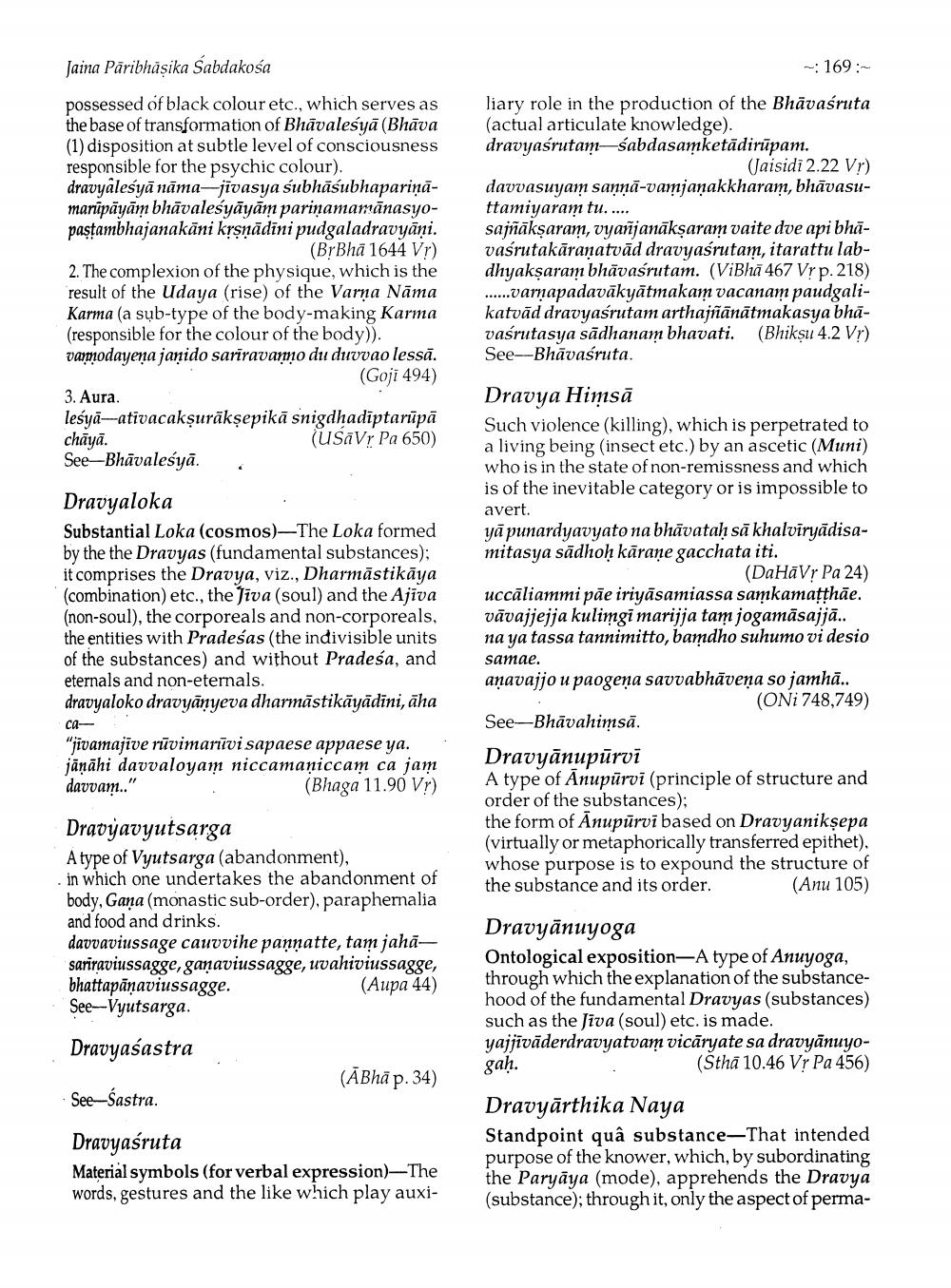________________
Jaina Pāribhāșika Sabdakośa
- 169:
possessed of black colour etc., which serves as the base of transformation of Bhāvalesyā (Bhāva (1) disposition at subtle level of consciousness responsible for the psychic colour). dravyâlesyā nāma-jīvasya śubhāśubhapariņāmarūpāyām bhāvalesyāyām parinamamānasyopastambhajanakāni krsnādini pudgaladravyāni.
(BrBhā 1644 Vr) 2. The complexion of the physique, which is the result of the Udaya (rise) of the Varņa Nāma Karma (a sub-type of the body-making Karma (responsible for the colour of the body)). vammnodayena jaạido sarīravamo du duvvao lessā.
(Goji 494) 3. Aura. lesyā--ativacakşurākṣepikā snigdhadīptarūpā chāyā.
(USãVr Pa 650) See-Bhāvaleśyā.
liary role in the production of the Bhävasruta (actual articulate knowledge). dravyasrutam-sabdasamketädirūpam.
(Jaisidi 2.22 Vr) davvasuyam sannā-vamjanakkharam, bhāvasuttamiyaram tu..... sajñākşaram, vyañjanākşaram vaite dve api bhävasrutakāranatvād dravyasrutam, itarattu labdhyaksaram bhāvasrutam. (ViBhā 467 Vr p. 218) ......varnapadavākyātmakam vacanam paudgalikatvād dravyasrutam arthajñānātmakasya bhāvasrutasya sādhanam bhavati. (Bhiksu 4.2 Vr) See-Bhāvasruta.
Dravyaloka Substantial Loka (cosmos)—The Loka formed by the the Dravyas (fundamental substances); it comprises the Dravya, viz., Dharmāstikāya (combination) etc., the Jiva (soul) and the Ajiva (non-soul), the corporeals and non-corporeals, the entities with Pradeśas (the indivisible units of the substances) and without Pradeśa, and eternals and non-eternals. dravyaloko dravyānyeva dharmāstikāyādini, āha ca"jivamajive rūvimarīvi sapaese appaese ya. jānāhi davvaloyam niccamaniccam ca jam davvam.."
(Bhaga 11.90 Vr)
Dravya Himsā Such violence (killing), which is perpetrated to a living being (insect etc.) by an ascetic (Muni) who is in the state of non-remissness and which is of the inevitable category or is impossible to avert. yā punardyavyato na bhāvatah sākhalvīryādisamitasya sādhoh kārane gacchata iti.
(DaHāV? Pa 24) uccāliammi pāe iriyāsamiassa samkamatthāe. vāvajjejja kulimgi marijja tam jogamāsajjā.. na ya tassa tannimitto, bamdho suhumo vi desio samae. anavajjo u paogeņa savvabhāvena so jamhā..
(ONi 748,749) See-Bhāvahimsā. Dravyānupūrvi A type of Anupūrvi (principle of structure and order of the substances); the form of Anupūrvi based on Dravyanikṣepa (virtually or metaphorically transferred epithet). whose purpose is to expound the structure of the substance and its order. (Anu 105)
WUUUU
..
.
Dravyavyutsarga A type of Vyutsarga (abandonment), . in which one undertakes the abandonment of body, Gana (monastic sub-order), paraphernalia and food and drinks. davvaviussage cauvvihe pannatte, tam jahāsarīraviussagge, ganaviussagge, uvahiviussagge, bhattapāņaviussagge.
(Aupa 44) See--Vyutsarga.
Dravyānuyoga Ontological exposition-A type of Anuyoga, through which the explanation of the substancehood of the fundamental Dravyas (substances) such as the Jiva (soul) etc. is made. yajjīvāderdravyatvam vicāryate sa dravyānuyogah.
(Stha 10.46 Vr Pa 456)
Dravyasastra
(ĀBhāp. 34)
See-Sastra.
Dravyasruta Material symbols (for verbal expression)-The words, gestures and the like which play auxi
Dravyārthika Naya Standpoint quâ substance-That intended purpose of the knower, which, by subordinating the Paryāya (mode), apprehends the Dravya (substance); through it, only the aspect of perma




